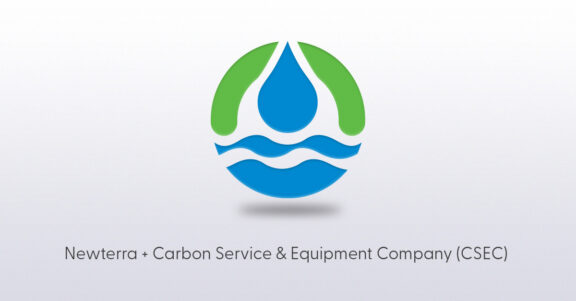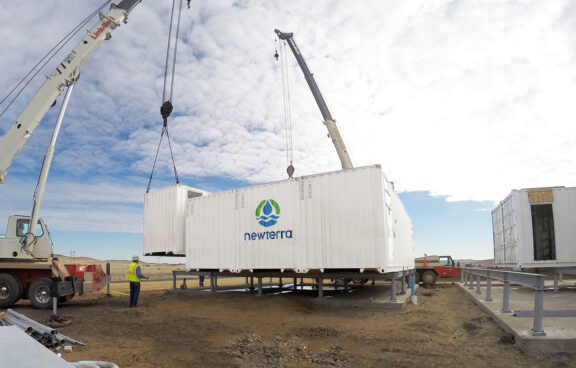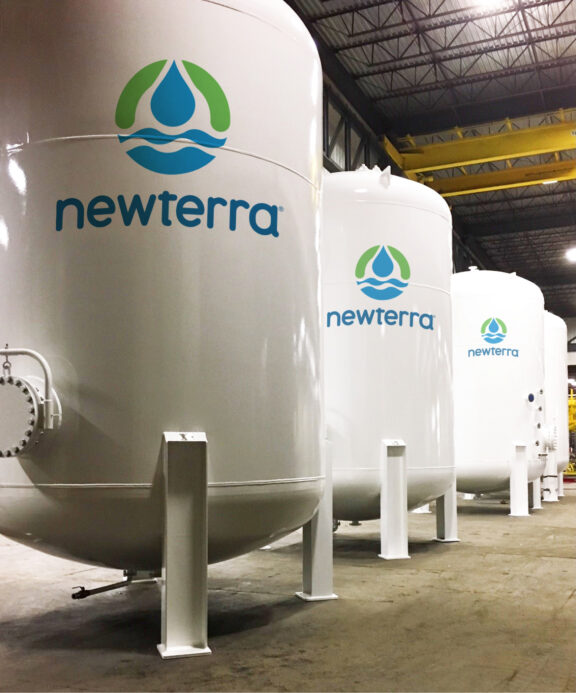Texas Has Real Water Challenges. Texas Water 2024 is a Showcase of Real Solutions.
Written by: Nathan Smith, SVP, Marketing & Lifecycle Leader – Newterra
Texas’ Water Woes and a Path of Innovation at Texas Water 2024
In the vast landscape of Texas, water is as much a symbol of life as it is of challenge. The state grapples with severe water supply issues, underscored by extreme drought conditions and an ever-increasing demand propelled by rapid population growth. Projections by the Texas Water Development Board sound the alarm, predicting a potential shortfall of 5 to 7 million acre-feet of water by 2070, urging a pivot towards innovative solutions like desalination, aquifer storage, and the reuse of treated produced water. The legislature’s allocation of $1 billion for water projects reflects a determined stride towards securing an additional 7 million acre-feet of water by 2033, aiming to quench the state’s thirst sustainably.
Compounding the scarcity issue is the aging water infrastructure, a silent crisis beneath the surface. Texas’ old water systems hemorrhaged an estimated 136 billion gallons of water in 2020 alone, laying bare the urgent need for modernization to stem the leaks, breaks, and contamination risks that plague the state. This situation is not just a technical failure but a looming public health concern, especially with the specter of harmful chemicals like PFAS in the oilfields’ produced water, highlighting the complexity of Texas’ water woes.
Against this backdrop, Texas Water 2024 emerges as a key event, spotlighting innovative technologies and solutions aimed at tackling these pressing issues. It offers a platform for professionals and stakeholders to explore advancements in water treatment, management, and conservation, reflecting a collective effort to address the complex water challenges facing Texas today.
This setting forms the basis for a comprehensive exploration of Texas’ water challenges and the technological and legislative initiatives underway to mitigate them, offering a pragmatic outlook on the state’s water future.
The Scope of Texas’ Water Problems
Texas faces a critical water crisis, compounded by severe drought conditions and an aging infrastructure that fails to meet the state’s growing needs. The Texas Water Development Board (TWDB) has forecasted a troubling scenario where the state could encounter a significant water deficit, projecting a shortage of 5 to 7 million acre-feet by 2070 if new water sources are not developed. Legislative efforts are underway to mitigate this looming crisis, with substantial investments directed toward securing additional water supplies through innovative solutions such as desalination plants and aquifer storage. More details on TWDB’s projections and initiatives can be found on their official website.
The aging water infrastructure in Texas is another pressing concern, with 2020 alone witnessing the loss of an estimated 136 billion gallons of water due to system failures. This not only signifies a substantial waste of a precious resource but also highlights the urgent need for modernization and repair of the state’s water distribution systems. The deterioration of these systems necessitates a comprehensive overhaul to prevent future losses and ensure water quality and reliability for all Texans. The American Society of Civil Engineers (ASCE) provides an Infrastructure Report Card that assesses the condition of Texas’ infrastructure, including water systems.
Moreover, the environmental and public health concerns stemming from oilfield wastewater disposal and PFAS (Perfluoroalkyl and Polyfluoroalkyl Substances) contamination have garnered significant attention. The disposal of produced water, particularly in the Permian Basin, involves chemicals that pose risks to both public health and the environment. Current regulations are deemed insufficient, covering only a fraction of the chemicals found in produced water. This has led to calls for more stringent water quality standards. Legislative efforts are ongoing to better regulate and oversee these practices, with proposed studies to assess the impact of PFAS in fracking and explore potential restrictions. Information on these concerns and legislative actions can be explored through resources like the Texas Tribune’s coverage of water issues in the state.
Together, these factors paint a comprehensive picture of the water-related challenges facing Texas. Immediate and strategic action is required to address the twin issues of supply shortages and infrastructure resilience, ensuring sustainable water management for the state’s future.
Legislative and Public Momentum for Solutions
Texas has been proactive in enacting legislation to address its water challenges, with Senate Bill 28 (SB 28) being a significant step. This bill, passed in 2021, established the Texas Water Fund, authorizing the Texas Water Development Board to use this fund for water supply projects and infrastructure upgrades. SB 28 is designed to generate substantial resources, aiming to secure 7 million acre-feet of new water over the next decade. The legislation emphasizes diverse strategies such as desalination, aquifer storage, and potable reuse projects. For a detailed overview of SB 28, visit the Texas Legislature Online.
Additionally, Proposition 6, approved by voters, created the Texas Water Fund with a $1 billion appropriation to enhance the state’s water infrastructure and initiate new water supply projects. This constitutional amendment emphasizes Texas’ commitment to sustainable water management and infrastructure modernization. The Texas Water Development Board’s official website provides more insights into the utilization and impact of this fund.
The Infrastructure Investment and Jobs Act (IIJA), a national initiative, also plays a crucial role in Texas, offering over $2 billion for clean and drinking water state revolving funds. This federal support is crucial for Texas, given its extensive water and wastewater infrastructure needs. The IIJA’s funds are aimed at enhancing water system resilience, with a significant focus on aiding small, rural, and disadvantaged communities. More information about the IIJA and its benefits for Texas can be found on the official federal infrastructure website.
In the words of Edd Hargett, Texas State Director for Rural Development, “Funding for infrastructure is vital in helping rural communities keep pace with their rising populations.” He underscores the role of modern water infrastructure in driving economic opportunity and enhancing the quality of life. Hargett’s statement, accessible through USDA Rural Development, highlights the interconnectedness of infrastructure investment and community well-being.
Jeremy Mazur, a Senior Policy Advisor at Texas 2036, points out the critical state of the infrastructure, noting, “This is a crisis that endangers economic development and community vitality across Texas.” His commentary, found on Texas 2036’s website, emphasizes the urgent need for strategic investments and policy reforms to address the water infrastructure crisis effectively.
Technological Solutions
Upgrading Aging Infrastructure with Modern Technologies in Texas

Smart Water Management Systems: Texas can benefit from integrating IoT sensors and AI analytics into its water systems. These technologies enable real-time monitoring, predictive maintenance, and optimization of water distribution, enhancing efficiency and reliability. The Texas Commission on Environmental Quality often discusses the potential of such smart systems in improving water management across the state. Even at smaller scales and in rural areas, digital technologies can act as force multipliers for boots on the ground operators, allowing a dwindling population of water experts to serve a wider footprint of decentralized water and wastewater treatment assets.
Newterra Digital Solutions
Pipeline Rehabilitation and Replacement: The state’s water infrastructure, plagued by old and leaky pipes, requires upgrades. Modern trenchless technologies, like CIPP and pipe bursting, offer effective solutions for repairing aging pipelines, reducing water loss and preventing system failures. Details on these methods are available through industry resources like the North American Society for Trenchless Technology.
Advanced Water Treatment Technologies: To tackle the issue of water contamination, including chemicals like PFAS, Texas can adopt advanced treatment methods such as membrane filtration and advanced oxidation. These processes provide superior contaminant removal, ensuring safer drinking water. The Water Environment Federation provides insights into these advanced treatment technologies.
Energy-Efficient Equipment Upgrades: Many of Texas’ water facilities operate with outdated, inefficient equipment. Upgrading to high-efficiency pumps, blowers, and HVAC systems can significantly cut energy use and operational costs. Particularly, Texas’ numerous oxidation ditches that rely on 70-year old rotor and disc-based aeration systems would greatly benefit from transitioning to advanced process-aeration technologies, which offer enhanced oxygen transfer efficiency and lower energy consumption. Information on these and other energy-efficient solutions can be found through the American Council for an Energy-Efficient Economy.
By adopting these modern technologies, Texas can address the current deficiencies in its water infrastructure, paving the way for a more efficient, sustainable, and resilient water management system.

Decentralized Wastewater Treatment: Tailoring Solutions for Texas’ Unique Landscape
Decentralized wastewater treatment offers a scalable, cost-effective solution for Texas, especially crucial for its vast rural and small community landscapes. These systems are increasingly relevant in areas where conventional sewer infrastructure is not viable, providing localized treatment that reduces long-distance transport and infrastructure costs. With about 5.8 million Texans relying on such systems, they are pivotal in areas lacking centralized facilities. Decentralized systems, adaptable and efficient, are essential for managing wastewater in Texas’ diverse geographical settings, ensuring environmental protection and sustainable resource management. More on this can be found in the TWRI article.
In Texas, where distances are vast and many communities are dispersed, decentralized systems offer a cost-effective way to manage wastewater without the need for extensive infrastructure. They can be scaled to serve small populations and expanded as communities grow, providing flexibility and efficiency. Decentralized systems, such as those explored in Newterra’s previous article on Revitalizing Rural America, underscore the potential for these technologies to enhance rural and remote areas’ resilience and sustainability.
The benefits of decentralized wastewater treatment in Texas include:

- Localized Treatment: By treating wastewater close to where it is generated, these systems reduce the need for long-distance transport, minimizing infrastructure costs and energy use.
- Scalability and Flexibility: Decentralized systems can be designed to meet the specific needs of a community, whether it’s a small rural town or a growing suburban area, and can be expanded modularly as the population grows.
- Environmental Protection: These systems can be tailored to meet strict effluent quality standards, protecting Texas’ diverse ecosystems, including its rivers, lakes, and coastal areas.
- Economic Advantages: By avoiding the high costs associated with constructing and maintaining traditional sewer systems, decentralized treatment can provide a more economically viable solution for smaller communities.
Newterra Decentalized Systems
For Texas, where approximately 3.6 million Texans live outside major metro areas in rural towns and agricultural lands, adopting decentralized wastewater treatment systems can lead to significant improvements in water quality management, public health, and environmental sustainability. The state’s varied landscape, from the arid West to the humid East, necessitates adaptable and efficient wastewater solutions that decentralized systems can aptly provide.
Decentralized wastewater treatment systems represent a forward-thinking approach to managing Texas’ water resources, offering tailored, sustainable, and cost-effective solutions for communities across the state.
Advanced Treatment Solutions: Enhancing Water Quality in Texas
In Texas, where water quality issues are compounded by industrial activities and natural contaminants, advanced treatment solutions like reverse osmosis (RO) and granular activated carbon (GAC) play a crucial role in ensuring safe drinking water. These technologies are effective in removing a wide range of contaminants, including PFAS, which have become a significant concern across the state.
Reverse Osmosis (RO): RO is a filtration method that removes contaminants from water by passing it through a semipermeable membrane. It is particularly effective in demineralizing or desalinating water, making it an essential process in areas affected by drought and in communities relying on brackish groundwater. In Texas, RO helps in tackling the scarcity of freshwater resources by transforming brackish water into potable water, thus addressing both quantity and quality issues. The Texas Commission on Environmental Quality (TCEQ) provides guidelines and information on the use of RO and other treatment technologies.
Granular Activated Carbon (GAC): GAC treatment is renowned for its ability to adsorb organic compounds and remove chemical contaminants, including chlorinated solvents, pesticides, and PFAS. Its porous nature allows for effective trapping of contaminants, significantly improving water taste, odor, and safety. GAC systems are versatile and can be used in both large-scale municipal water treatment facilities and smaller, community-based systems. The Environmental Protection Agency (EPA) discusses GAC and its role in treating drinking water, providing a resource for understanding its importance in contaminant removal.
Newterra Potable Water Treatment Systems

Both RO and GAC technologies are integral to Texas’ strategy for addressing its water quality challenges. They provide robust solutions for removing harmful contaminants and ensuring that water meets health and safety standards. As Texas continues to confront issues like PFAS contamination and the need for sustainable water sources, these advanced treatment solutions are pivotal in securing safe and clean water for its residents.
Incorporating these advanced treatment methods supports Texas’ ongoing efforts to manage its water resources effectively and protect public health, aligning with both state and federal regulatory standards for water quality.
Navigating Towards Sustainable Water Solutions in Texas
Addressing Texas’ water issues necessitates a harmonious blend of innovative technology and proactive legislative action. The challenges faced by the state—ranging from severe droughts and aging infrastructure to contamination threats—underscore the critical need for comprehensive and sustainable water management solutions. The Texas Water show emerges as a crucial platform in this context, spotlighting the technological advancements and collaborative efforts essential for steering Texas towards a secure water future.
In the face of these challenges, technology and innovation stand as pillars upon which Texas can build its strategy for effective water management. The event underscores the significant role of modern solutions, from smart water management systems and advanced treatment technologies to energy-efficient processes, in addressing the state’s complex water needs.

Newterra is set to showcase its comprehensive portfolio of water treatment solutions at Texas Water 2024, offering a significant step towards addressing the state’s water challenges. Visit us at booth 1645 and let’s start a conversation about scalable, cost-effective, and environmentally sustainable water and wastewater management practices.
Newterra, with its complete portfolio of water treatment solutions, is poised to contribute significantly to these efforts. By engaging with stakeholders at Texas Water 2024, Newterra aims to foster discussions around scalable, cost-effective, and environmentally sustainable water and wastewater management practices. Newterra’s commitment to innovation aligns with Texas’ goals, offering a pathway to resolve the state’s water challenges through advanced technologies and strategic partnerships.
We encourage all stakeholders attending Texas Water 2024 to engage, explore the vast solutions presented, and discuss how we can collectively work towards a comprehensive strategy for sustainable water management in Texas. Join the conversation and discover how we can collaborate to safeguard Texas’ water future.
To learn more about Newterra and our solutions, we invite you to visit our LinkedIn page and website, where you can find more information and connect with our team of experts. Together, we can chart a course towards a sustainable and water-secure Texas.


